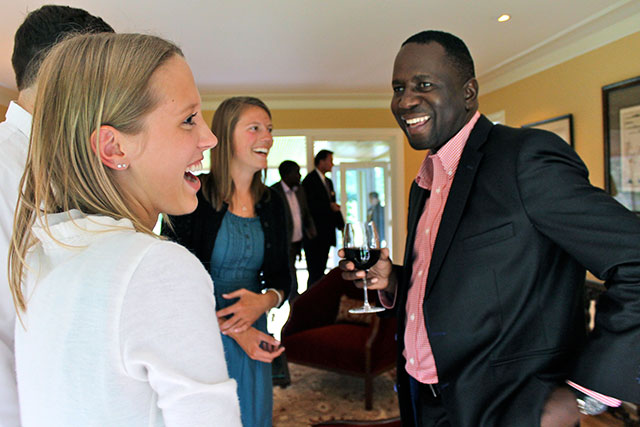Page 423 • (13,161 results in 0.039 seconds)
-
The Spring 2024 History Capstone Class (Prof. Gina Hames). Photo credit: M. Halvorson The History Department is pleased to present the 2024 Spring Capstones Saturday, May 18th – Xavier Hall, Room 201 – 9:00 am-3:00 pm Click on each student name to see their presentation title. 9:00-10:00 am - RELIGION - Comment: Dr. Michael HalvorsonAdam SeifredMaddie GebhardOlivia DotyAdam SeifredThe Role of Martyrdom in Furthering the Goals of the Early Christian ChurchMaddie Gebhard``More of a Family Now
-
Learn More: Zulu Hat 1The flared shape of these Zulu women’s hats (isicholo), dyed with red ochre, reflect the original design of the hairstyle on which they are based. Originally a mother would sew her daughter’s hair into this complex design for the initial stage in the series of ceremonies associated with her daughter’s marriage. The hats are a relatively new aspect of Zulu traditional dress that were developed in the late 19th or early 20th century and are based on the cone-shaped hairstyle
-
Learn More: Zulu Hat 2The flared shape of these Zulu women’s hats (isicholo), dyed with red ochre, reflect the original design of the hairstyle on which they are based. Originally a mother would sew her daughter’s hair into this complex design for the initial stage in the series of ceremonies associated with her daughter’s marriage. The hats are a relatively new aspect of Zulu traditional dress that were developed in the late 19th or early 20th century and are based on the cone-shaped hairstyle
-
Learn More: Zulu Hat 3The flared shape of these Zulu women’s hats (isicholo), dyed with red ochre, reflect the original design of the hairstyle on which they are based. Originally a mother would sew her daughter’s hair into this complex design for the initial stage in the series of ceremonies associated with her daughter’s marriage. The hats are a relatively new aspect of Zulu traditional dress that were developed in the late 19th or early 20th century and are based on the cone-shaped hairstyle
-
Introduction: African ArtIn terms of land mass, Africa is a large continent, in which all of the United States, Europe, China, India, Mexico and Japan could easily fit. It is also a place of tremendous diversity, in terms of languages spoken, ethnic identities, cultural traditions, environments in which people live and work, and historic experiences. Sadly, popular culture has profoundly shaped what Africa, Africans, and their rich and diverse cultures are “supposed” to look like, emphasizing
-
Our Story In 2003, former PLU provosts Paul Menzel and Patricia Killen secured a $2 million grant from the Lilly Endowment to launch a program for the exploration of vocation at PLU. What do we mean by vocation? Our understanding of this term is informed by Martin Luther’s view: a vocation is a calling to work with others for the good of others. In the Wild Hope Center for Vocation we speak of vocation as being called to promote human and ecological flourishing. This understanding aligns
-

April 7, 2011 Gift for all-purpose field primes athletic facilities transformation By Greg Brewis Transforming PLU athletic and recreational facilities took a big step forward recently. A gift of $1 million for the construction of an all-weather, multipurpose athletic field on lower campus, is making that closer to a reality. New all-weather, multipurpose athletic field would transform athletic, recreation and wellness opportunities on campus. The gift from Wilson Construction and the Don and
-
253.535.7237 www.plu.edu/honors/ dowland@plu.edu Seth Dowland, Ph.D., Director International Honors Requirements7 courses, 28 semester hours distributed as follows: IHON 111 – 112: Origins of the Contemporary World 8 semester hours Normally taken sequentially in the first year. These courses explore the historical roots and global dimensions of contemporary events, values and traditions. IHON: Four 200-level courses 16 semester hours Normally taken in the second and third year. A wide range of
-

team from Pacific Lutheran University is installing a life-changing well. Unfortunately, the parachute also cuts the breeze and traps the heat from the pumps. Still, shade is shade, so four of the students doggedly work through the afternoon as the drill grumbles and chews its way through 150 feet of mud, rock and clay to an aquifer beneath the village, which is about three hours from Managua and on the edge of a smoldering garbage dump. Branden Stallard ’16 and Rachel Espasandin ’14 get soaked in
-

August 14, 2013 A group of dignitaries from Namibia visited PLU this summer. Namibian homecoming to PLU By Joanne Lisosky, professor of communication Included among the delegation of Namibian dignitaries touring the Pacific Lutheran University campus last week was a proud alumnus, Edwin Tjiramba, who delighted in sharing his fond memories of PLU. “I was born in Namibia, but my future was born at PLU,” Tjiramba said with a wide grin. Tjiramba currently serves as the Communication and Marketing
Do you have any feedback for us? If so, feel free to use our Feedback Form.


